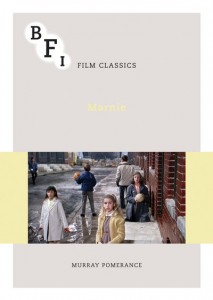Marnie (BFI Classics) by Murray Pomerance (Palgrave Macmillan, August 2014), 96 pages, ISBN: 978-1844576548 (paperback), £12.99
 About the reviewer: Dr Susan Smith is Senior Lecturer in Film Studies at the University of Sunderland. She is author of Hitchcock: Suspense, Humour and Tone (2000) and her other publications include Elizabeth Taylor (2012), Voices in Film (2007), The Musical: Race, Gender and Performance (2005).
About the reviewer: Dr Susan Smith is Senior Lecturer in Film Studies at the University of Sunderland. She is author of Hitchcock: Suspense, Humour and Tone (2000) and her other publications include Elizabeth Taylor (2012), Voices in Film (2007), The Musical: Race, Gender and Performance (2005).
Despite or because of its status as the most critically contested of Hitchcock’s major works, Marnie (1964) has attracted some notably impassioned scholarly writing in recent years. In a 1999 CineAction article, Robin Wood, always a staunch advocate of the film’s greatness, famously observed that: ‘Anyone who doesn’t love Marnie doesn’t really love Hitchcock’ (1999: 84), a claim he extended in the 2002 DVD release of the film: ‘I would go further than that and say if you don’t love Marnie then you don’t really love cinema’ (quoted in Moral 2013: viii). In a lengthy, all-new chapter on the film in his second, revised edition of Hitchcock – The Murderous Gaze (2012), William Rothman thoughtfully modified Wood’s claim, observing: ‘The truth is, though, that Marnie can be a difficult film to love even if you do love cinema’ and that: ‘you cannot love Marnie, you cannot know what makes it worthy of  love, if you don’t really love cinema’ (351). In the intervening years, a chapter on Marnie appeared in Murray Pomerance‘s An Eye For Hitchcock (2004) and Tony Lee Moral’s Hitchcock and the Making of Marnie (2005) has provided us with an extensively researched account of the film’s production history (challenging what Moral regards as the media exaggerations and distortions that have built upon around the making of the film, his 2013 revised edition takes issue with the BBC/HBO TV drama The Girl‘s controversial behind-the-scenes reconstruction of Hitchcock’s troubled relationship with actress Tippi Hedren during the making of The Birds (1963) and Marnie). Given this trend towards reassessment of the film’s achievements and status – as a key work of personal authorship and an important landmark in cinema history – the BFI’s recent publication of a new volume on Marnie by Murray Pomerance in its Film Classics series could not be more timely.
love, if you don’t really love cinema’ (351). In the intervening years, a chapter on Marnie appeared in Murray Pomerance‘s An Eye For Hitchcock (2004) and Tony Lee Moral’s Hitchcock and the Making of Marnie (2005) has provided us with an extensively researched account of the film’s production history (challenging what Moral regards as the media exaggerations and distortions that have built upon around the making of the film, his 2013 revised edition takes issue with the BBC/HBO TV drama The Girl‘s controversial behind-the-scenes reconstruction of Hitchcock’s troubled relationship with actress Tippi Hedren during the making of The Birds (1963) and Marnie). Given this trend towards reassessment of the film’s achievements and status – as a key work of personal authorship and an important landmark in cinema history – the BFI’s recent publication of a new volume on Marnie by Murray Pomerance in its Film Classics series could not be more timely.
In certain respects, Pomerance’s study is a beneficiary of that earlier work, freeing this scholar from rehearsing the fraught debates and media hype surrounding the film and its production and providing outlet for his own personal form of film criticism. Divided into five chapters, the book conforms, on one level, to a linear structure: the first, beginning with the opening shot of Marnie on the empty railway platform, explores the complex relevance of flight (or ‘fugue’) to the female protagonist while the final one deals with the climactic denouement at her mother’s house. Within the chapters, however, Pomerance allows his analysis a more idiosyncratic, free-flowing mode of expression, at times shuttling between scenes (‘Remembering a film is not the same as watching it’, he observes at one point, ‘One passes back and forth through its corridors, gathering snatches out of syntactical order’ (p.25)), elsewhere meditating on the overlooked significance of various objects and other details. While some might find this modus operandi occasionally frustrating and/or disorientating, it yields memorable insights, endowing the significance of elements such as the pecan pie that Marnie’s mother prepares for the child, Jessie, with a surprising logic. When it comes to the more well-covered terrain of the honeymoon sequence, Pomerance engages with the ongoing question of whether Mark’s actions are presented as a rape of the heroine, perceptively arguing for the multi-layered complexity of Marnie’s rejection of Connery’s character and its possible roots in her earlier childhood trauma (this tension between Marnie’s child and adult selves resurfaces in the discussion of the ending in chapter 5 and with telling sensitivity to the often underrated qualities of Hedren’s performance). Although Pomerance’s reading of the honeymoon sequence is contentious in its claims (which might have been strengthened if he had done more to anticipate potential challenges to his argument), it provides rich material for scholarly debate and classroom discussion.
To categorise Pomerance’s book purely according to a tradition of detailed film criticism would be to neglect two main ways in which it departs from this: (1) by combining close reading of the movie with some illuminating analysis of production sources (of the kind that Moral’s book – which Pomerance never discusses - is centrally based around); and (2) by interpreting the film in light of the historical conflict between the American North and South. In the first case, the book’s yolking of a close reading approach with archival analysis can occasionally be a little cumbersome. It does produce significant rewards, though, most notably perhaps when demonstrating (in an effective riposte to ‘the critique of Hitchcock’s technical infirmities’ in Marnie, p.69) how the director creatively honed sequences like the one at the Atlantic City racecourse (see Chapter 4, ‘Face-off’) or when bringing out the film’s preoccupations with social class and patriarchal capitalism (the disclosure of one section of dialogue cut from the script actually provides the basis for chapter 2’s title, ‘Droit du Seigneur’). This insightful use of production sources supports, in turn, the North/South subtext that the study uncovers in the film, the findings of which (in Chapter 3, ‘Confederacy’) constitute one of the book’s main claims to originality.
Overall, Pomerance’s eloquent (and, yes, impassioned) study offers a welcome complement to the expanding body of work on Marnie, thoughtfully building on what went before and offering fresh insights and new lines of enquiry.
Dr Susan Smith